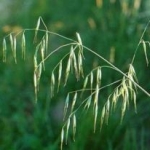| Common Name: |
Wild Oats |
| Other Names: |
Groats, Haver, Haver-Corn, Oat Bran, Oats, Oatstraw |
| Botanical Name: |
Avena sativa |
| Genus: |
Avena |
| Family: |
Poaceae |
| Native Location: |
Worldwide |
| Cultivation: |
Well-drained, moist, fertile soil in sun. |
| Propagation: |
By seed sown in spring. |
| Harvest: |
Plants are cut in summer before fully ripe and threshed to separate the grains, which are dehusked and rolled for use as cereals, and in liquid extracts, and tinctures. Dried stalks are sometimes included in tonics. |
| Height: |
30cm-1m (1-3ft) |
| Width: |
15-23cm (6-9in) |
| Hardiness: |
Hardy |
| History: |
Oats are one of the many plants that straddle the fine line between "herb" and "food". They have been a staple human and animal crop, worldwide, since prehistoric times. For centuries—before vitamin and mineral supplements arrived on the scene to fill in the gaps created by poor nutrition and stress—old-time herbalists, midwives, and rural doctors relied heavily on oats for their superb nourishing and restorative powers. Oats were the first choice for strengthening the body after childbirth, a long bout with illness, or simple nervous exhaustion. In fact, the plant's Latin name, avena, means "nourishing". While the term "oats" and "oat straw" are often used interchangeably (as they are here), technically "oats" are the husked oat seeds, and "oat straw" is the whole plant, harvested when the seeds are ripe. And it is the whole plant that delivers the biggest medicinal bang. |
| Parts Used: |
Seeds, stalks ("straw"), Fruit. |
| Properties: |
A mealy, nutritive herb that acts as a tonic to the heart, nerves, and thymus gland, and is externally emollient. Regular consumption of oat germ reduces cholesterol levels. |
| Medicinal Uses: |
Internally for depression, nervous exhaustion, shingles, herpes, menopausal symptoms, and debility following illness. Externally in preparations for eczema and dry skin. Often combined with Cypripedium parviflorum var. pubescens (See American valerian) or Scutellaria laterifolia (See Virginia Skullcap) for depression.
To lower cholesterol and treat gout, rheumatism, skin diseases, insomnia, and symptoms of old age.
Oats have antidepressant, antispasmodic, demulcent, nutritive, and stimulating properties, as well as a general calming effect on the nervous system. Avenine, one of oats' principal chemical ingredients, is responsible for the herb's sedating action. As a source of nutrition, oats have few herbal rivals. They are rich in glycosides, iron, manganese, phosphorus, potassium, proteins, vitamins E and K, the B vitamins, and zinc. As a restorative tonic oats targets the bones, endocrine system, heart, intestines, nervous system, tissues, and thymus gland. The whole plant—in cereal/grain form or in decoctions—is prescribed internally for general debilitation, stress, exhaustion, depression, estrogen deficiencies, gastritis, high cholesterol, and impaired immune function. Externally, oats are used in baths and facial masks to soothe and heal dry skin, skin rashes, eczema, and poison ivy. |
| Preparation: |
Oats are widely available as grains and kernels and may be cooked and eaten in breads, cereals, muffins, and porridges. Oats are also available as dried oatstraw. To make a tea, pour 1 cup of boiling water over 3 teaspoons of dried oat straw and steep for 15 minutes. Strain and drink up to 3 cups a day. |
| Typical Dose: |
A typical dose of oats to lower cholesterol is 50 to 100 gm, four times a day. |
| Caution: |
If you are gluten-intolerant, avoid using oats. |
| Possible Side Effects: |
Oats' side effects include bloating and flatulence. |
| Drug Interactions: |
| Taking oats (in the form of oat bran) with these drugs may interfere with the absorption and effectiveness of the drug: |
| All Drugs Taken By Mouth, (All Oral Drugs) |
Atorvastatin, (Lipitor) |
Fluvastatin, (Lescol) |
Lovastatin, (Altocor, Mevacor) |
| Pravastatin, (Novo-Pravastatin, Pravachol) |
Rosuvastatin, (Crestor) |
Simvastatin, (Apo-Simvastatin, Zocor) |
| Taking oats with these drugs may reduce the effects of the drug: |
| Morphine Hydrochloride, (Morphine Hydrochloride) |
Morphine Sulfate, (Kadian, MS Contin) |
|
| Lab Test Alterations: |
- Oat bran may lower the results of after-eating blood sugar and insulin tests.
- Oat bran lowers the results of cholesterol tests.
|
| Culinary Uses: |
Seeds are milled as oatflakes, rolled oats, or flour. Flakes and rolled oats are popular for breakfast in the form of oatmeal and muesli. They are also ingredients of toasted cereal snacks, breads, cookies, pancakes, and specialty beers. Oat bran is added to breakfast cereals. Low fat, lactose-free oat milk is used as a milk substitute. Seeds are sprouted for salads, dried for granola, or grown longer as seedlings then juiced or dried for food supplements. |
| Bibliography: |
Encyclopedia of Herbs by Deni Brown Copyright © 1995, 2001 Dorling Kindersley Limited. pp 138-139
The Essential Herb-Drug-Vitamin Interaction Guide by Geo. T. Grossberg,MD and Barry Fox,PhD Copyright©2007 Barry Fox,PhD. Pg. 353
The Modern Herbal Primer by Nancy Burke Copyright©2000 Yankee Publishing, Inc. pp.34-35 |

